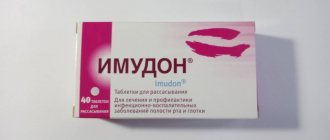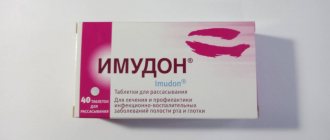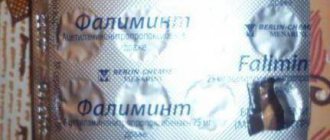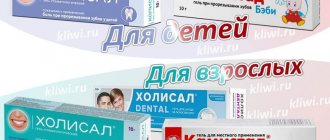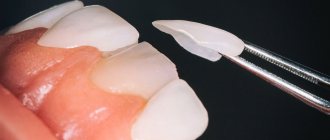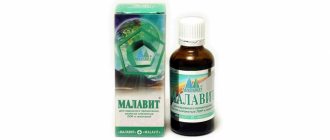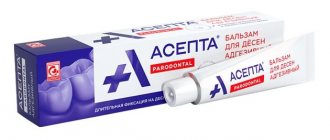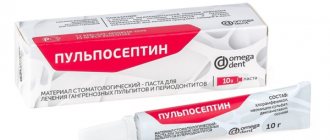Imudon is a drug from the group of immunostimulants produced in Russia. The tablets are of bacterial origin and can be used in the treatment of dental diseases and dysfunction of the ENT organs.
Also, the drug is used to prevent secondary infection after implantation of an artificial tooth root, during the preparation period, and also after tonsillectomy.
In general, the medicine is well tolerated by patients of all age groups. However, due to the high cost, or in the presence of autoimmune diseases, it is necessary to replace Imudon with cheaper analogues, and their effectiveness should be no lower than the original product.
pharmachologic effect
The drug helps provide an immunostimulating effect similar to a vaccine. The effect of Imudon is due to its ability to stimulate the process of capture and digestion of solid particles that are part of pathogenic microorganisms.
Under the influence of the drug, the quantitative content of lysozyme, interferon, and immunoglobulins— the main immune cells of the body—increases.
The tablets consist of a polyvalent antigenic complex - a mixture of bacteria and products of their breakdown into individual enzymes, which include elements of the cell walls and intracellular contents of the microorganism.
The medicine has a composition similar to the causative agents of those pathological processes that are most often observed in the mouth and pharynx, due to which the body begins to intensify the production of its own protective bodies against specific types of bacteria.
Indications for use
According to the instructions for use, Imudon is used during treatment and prevention:
- Superficial and deep periodontal disease, glossitis, aphthous stomatitis.
- Dysbacteriosis of the oral cavity.
- Catarrhal and ulcerative gingivitis.
- Periodontitis in acute and chronic course.
- Pharyngitis.
- Chronic form of tonsillitis.
- Acute and chronic infectious or aphthous stomatitis.
- Traumatic or decubital lesions of the mucous membranes of the oral cavity.
- To prevent secondary infection before and after surgery in the oral cavity.
The drug is widely used by maxillofacial surgeons. The medicine can also be used for ulcers caused by dentures.
Dosage for adults and children
For patients over 14 years of age, the total dosage is 8 tablets per day, and Imudon must be taken at regular intervals (every 1-2 hours.)
The duration of the course for the treatment of acute forms or exacerbations of chronic pathologies is 10 days. To prevent immunodeficiency, the dosage is reduced to 6 tablets per day, and the total duration of administration is increased to 20 days.
Children of younger age groups from 3 to 14 years are prescribed 6 tablets per day, at least two hours should pass between doses. The course of treatment for acute forms and exacerbations is 10 days, prophylaxis lasts 20 days. In both cases, the number of tablets remains the same - 6 per day.
The total number of treatment and preventive courses is no more than four per year.
Contraindications and side effects
Imudon is not recommended for use in case of individual intolerance to active or auxiliary substances, as well as in case of:
- Treatment of patients under 3 years of age.
- Therapy for people with autoimmune diseases.
The drug is well tolerated. According to patient reviews, in a number of cases the development of:
- Allergic reactions: rash, urticaria, angioedema.
- Disorders of the gastrointestinal tract: nausea, vomiting, pain impulses in the abdominal area.
- Increased body temperature.
- Cough and exacerbations of bronchial asthma.
- In isolated cases, erythema nodosum, thrombocytopenia, and hemorrhagic vasculitis occurred.
If patients notice the occurrence of these or any other undesirable side effects, they should inform their doctor as soon as possible.
Flavors
| Flavor | A drug |
| Pineapple | Agisept |
| Suprima-ENT | |
| Anise-licorice | Novosept Forte |
| Orange | Agisept |
| Astrasept | |
| Hexoral tabs classic, Hexoral tabs extra | |
| Gorpils | |
| Novosept Forte | |
| Rinza Lorsept, Rinza Lorsept Anesthetics | |
| Stopangin 2A | |
| Strepsils with vitamin C | |
| Suprima-ENT | |
| Orange-menthol | Astrasept |
| Cherry | Dr. Theiss Angisept |
| Neo-angin | |
| Cherry-menthol | Astrasept |
| Ginger-lemon | Astrasept |
| Classic | Agisept |
| Strawberry | Gorpils |
| Stopangin 2A | |
| Suprima-ENT | |
| Citric | Agisept |
| Astrasept | |
| Hexoral tabs classic, Hexoral tabs extra | |
| Gorpils | |
| Dr. Theiss Angi Sept | |
| Rinza Lorsept, Rinza Lorsept Anesthetics | |
| Stopangin 2A | |
| Suprima-ENT | |
| Crimson | Grammidin for children |
| Suprima-ENT | |
| Honey-lime | Septolete Plus |
| Honey-lemon | Agisept |
| Astrasept | |
| Hexoral tabs classic, Hexoral tabs extra | |
| Gorpils | |
| Novosept Forte | |
| Rinza Lorsept, Rinza Lorsept Anesthetics | |
| Strepsils | |
| Strepsils Intensive | |
| Suprima-ENT | |
| Honey-linden | Dr. Theiss Angi Sept |
| Menthol | Theraflu LAR Menthol |
| Suprima-ENT | |
| Menthol-eucalyptus | Agisept |
| Astrasept | |
| Gorpils | |
| Novosept Forte | |
| Strepsils with menthol and eucalyptus | |
| Mint Lemon | Tantum Verde |
| Mint | Grammidin Neo |
| Stopangin 2A | |
| Sea buckthorn | Dr. Theiss Angi Sept |
| Blackcurrant | Hexoral tabs classic, Hexoral tabs extra |
| Rinza Lorsept, Rinza Lorsept Anesthetics | |
| Blackcurrant-menthol | Astrasept |
| Sage | Dr. Theiss Angi Sept |
| Eucalyptus | Suprima-ENT |
List of analogues is cheaper
As a prevention of ENT diseases during pregnancy, Lizobact is a safe and cheap replacement for the original immunostimulant.
The price of Imudon in January 2022 is from 470 rubles. for 24 pcs., from 610 rub. for 40 tablets. If we consider a 10-day treatment course for adults, then you will need two packages of 40 tablets, which will amount to an average of 1,220 rubles.
Prevention will cost from 1830 rubles and will require 120 tablets. Patients often ask whether there are analogues of Imudon that are cheaper, but no less effective?
Imudon does not have exact structural analogues (generics), so if necessary, the doctor can offer a list of drugs that are similar in their action, from a similar pharmacological group, but with a different composition.
- Anaferon - from 210 rub. A homeopathic remedy that has a similar immunomodulatory and anti-inflammatory effect. Treatment begins with the appearance of the first symptoms of the disease. After improvement occurs, it is recommended to use the tablets for 1 week - 10 days. The medication is well tolerated by patients; in rare cases, allergic reactions have been reported.
- Derinat - from 290 rub. An inexpensive immunostimulant that activates cellular and humoral immunity. The drug is intended for local use, preparing a solution for rinsing the mouth, applying applications, and performing irrigations. The medicine is well tolerated by patients.
- Ribomunil - from 260 rub. A cheap analogue of Imudon based on bacterial ribosomes: the most common pathogens of infectious diseases affecting the upper respiratory tract and ENT organs.
At the beginning of treatment, nausea, vomiting, excessive salivation, stool disorders, and allergies may develop. This is normal and there is no need to stop the medication.
The drug is recommended to be used in the morning, on an empty stomach.
During the first 3 weeks, the medication is taken on the first 4 days of the week. In the next 5 months - in the first 4 days of each month.
The selection of similar drugs and substitutes should be trusted to a qualified doctor. Self-medication is unacceptable, as it may not provide the desired therapeutic result.
Analogues of Imudon for children
Also on the pharmaceutical market is the following list of analogues of Imudon for children:
- Bronchomunal-P – 1 capsule contains 3.5 mg of lyophilized bacterial lysate. Capsules are used once a day. The course of treatment is determined by the doctor, taking into account the indications prescribed in the instructions. If the child cannot swallow the capsule, its contents can be dissolved in water.
- Anaferon for children - the cost is from 210 rubles. for 20 tablets. The drug can be used in the treatment of children older than one month. The dosage regimen is also determined by the pediatrician.
- IRS 19 is a close analogue of Imudon. Can be used in the treatment of children from 3 years of age. The medicine demonstrates good organic stimulation, which manifests itself in the form of increased runny nose at the beginning of therapy.
- Ribomunil - when treating children, preference is given to the dosage form in the form of granules for internal administration.
It is recommended to trust the selection of a suitable drug to replace the original only to a pediatrician.
Composition of monocomponent drugs for sore throat
| Compound | Name |
| Antiseptic | |
| Acetylaminonitropropoxybenzene | Falimint |
| Ambazon | Faringosept |
| Cetylpyridinium chloride monohydrate | Septolete Neo |
| Gramicidin S | Gramicidin S |
| NSAIDs | |
| Benzydamine hydrochloride | Tantum Verde |
| Flurbiprofen | Strepsils Intensive |
Imudon or Lizobakt
Both drugs differ in their pharmacological action. If necessary, the doctor may recommend the combined use of these medications.
Lizobakt acts locally, tablets are prescribed for the treatment of chronic and acute tonsillitis, tonsillitis, pharyngitis, gingivitis, stomatitis, erosions affecting the oral cavity.
Lysobact is an antiseptic that is produced in the form of lozenges. The active substance of the drug has the ability to convert insoluble bacterial membranes into a soluble mucopeptide.
Tablets are used up to 4 times a day for a week. In the future, the doctor may decide to extend the course of using the antiseptic.
Both drugs are not recommended for use in the treatment of patients under 3 years of age, as well as in cases of individual intolerance to the active component. The cost of Lizobakt is from 280 rubles. for 30 lozenges.
Composition of multicomponent drugs for sore throat
| Name | Antiseptic | Antibiotic | Anesthetic | NSAIDs | Vitamins | Other components |
| Dr. Theiss Angi Sept | Dichlorobenzyl alcohol | — | — | — | — | Menthol, anethole, peppermint oil |
| Astrasept | Amylmetacresol + dichlorobenzyl alcohol | — | — | — | — | — |
| Agisept | — | — | — | — | — | |
| Hexoral Tabs classic | — | — | — | — | — | |
| Gorpils | — | — | — | — | — | |
| Rinza Lorsept | — | — | — | — | — | |
| Strepsils | — | — | — | — | — | |
| Strepsils with a warming effect | — | — | — | — | — | |
| Strepsils with cooling effect | — | — | — | — | — | |
| Suprima-ENT | — | — | — | — | — | |
| Hexoral Tabs Extra | — | Lidocaine | — | — | — | |
| Rinza Lorcept Anesthetics | — | — | — | — | ||
| Strepsils Plus | — | — | — | — | ||
| Strepsils with vitamin C | — | — | — | Ascorbic acid | — | |
| Neo-Angin | — | — | — | — | Levomenthol | |
| Strepsils with menthol and eucalyptus | — | — | — | — | ||
| Grammidin for children | Cetylpyridinium chloride | Gramicidin S | — | — | — | — |
| Grammidin neo | — | — | — | — | ||
| Grammidin with neo anesthetic | Oxybuprocaine hydrochoride | — | — | — | ||
| Septolete Plus | — | Benzocaine | — | — | — | |
| Theraflu Lar Menthol | — | Lidocaine hydrochloride | — | — | — | |
| Novosept Forte | — | Tetracaine hydrochloride | — | — | Zinc sulfate | |
| Septolete Total | — | — | Benzydamine hydrochloride | — | — | |
| Laripront | Dequalinium chloride | — | — | — | — | Lysozyme hydrochloride |
| Sebidin | Chlorhexidine hydrochloride | — | — | — | Ascorbic acid | — |
| Anti-Angin Formula | — | Tetracaine | — | — | ||
| Hexalize | Biclotymol | — | — | — | — | Enzyme Lysozyme + anti-inflammatory enoxolone |
| Septogal | Benzalkonium chloride | — | — | — | — | Menthol, thymol, mint oil, eucalyptus oil |
| Septolete, Septolete D | — | — | — | — | Peppermint oil, eucalyptus, levomenthol, thymol | |
| Stopangin 2A, Stopangin 2A forte | — | Tyrothricin (1 mg and 2 mg in Stopangin 2A and Stopangin 2A forte) | Benzocaine | — | — | — |
| Grammidin with neo anesthetic | — | Gramicidin S | Oxybuprocaine hydrochloride | — | — | — |
| Lysobacter | — | — | — | — | Pyridoxine hydrochloride | Lysozyme |
Ismigen or Imudon
Ismigen, like Imudon, is presented in the form of sublingual lozenges, which can be recommended for patients over 3 years of age. The pharmacological effect of the analogue is similar to the original due to the composition, which includes bacterial lysates:
- Staphylococcus aureus.
- Streptococcus pyogenes.
- Catarrhal micrococcus.
- Haemophilus influenzae type B.
- Klebsiella ozena.
- Klebsiella pneumonia.
- Pneumococcus.
Under the influence of Ismigen, stimulation of both local and systemic immunity is observed. As a result, there is a reduction in the frequency, severity, duration of acute respiratory infection, relief of symptoms in the form of cough, shortness of breath, and increased body temperature.
The drug is often prescribed for acute, subacute and recurrent pathologies affecting the ENT organs. A substitute for Imudon is used from the age of 3; the tablets should be taken on an empty stomach.
Isigmen is prescribed to patients with:
- Recurrent, acute and subacute infections affecting the upper and lower respiratory tract: bronchitis, tonsillitis, pharyngitis, rhinitis, otitis, sinusitis.
- Complications after a viral infection, including influenza.
- To prevent exacerbation of chronic bronchitis.
Imudon has a wider range of indications and a more extensive composition, which makes it possible to use it in the treatment of various dental diseases, and is also prescribed to patients who have had their tonsils removed. Otherwise the drugs are identical.
Ismigen has a more convenient method of administration: the manufacturer recommends using the medicine one tablet per day for 10 days, so the course of treatment will cost less than Imudon.
The cost of Ismigen is from 505 rubles. for 10 tablets, from 1290 rub. for 30 pcs.
Purpose depending on age
| Age | Trade name |
| Children over 3 years old and adults | Imudon |
| Ismigen | |
| Lysobacter | |
| Tantum Verde | |
| Faringosept | |
| Children over 4 years old and adults | Grammidin for children |
| Grammidin Neo | |
| Grammidin with neo anesthetic | |
| Gramicidin S | |
| Septogal | |
| Septolete | |
| Septolete D | |
| Septolete Neo | |
| Children over 5 years old and adults | Agisept |
| Anti-Angin Formula | |
| Gorpils | |
| Dr. Theiss Angisept | |
| Strepsils | |
| Strepsils with vitamin C | |
| Strepsils with menthol and eucalyptus | |
| Falimint | |
| Children over 6 years old and adults | Hexalize |
| Hexoral tabs classic | |
| Neo-Angin | |
| Septolete Plus | |
| Strepsils with a warming effect | |
| Suprima-ENT | |
| Theraflu LAR Menthol | |
| Children over 12 years old and adults | Hexoral tabs extra |
| Sebidin | |
| Strepsils intensive | |
| Strepsils with cooling effect | |
| Strepsils Plus | |
| Adults (from 18 years old) | Novosept forte |
| Septolete total | |
| Stopangin 2A | |
| Stopangin 2 A forte | |
| Age restrictions are not indicated in the instructions | Laripront |
Bronchomunal or Imudon
Bronchomunal is an immunomodulatory drug with a multicomponent composition intended for internal use. Helps reduce the frequency and severity of infectious diseases affecting the upper respiratory tract, as well as reduce the duration of use of drugs with antibacterial action.
It is not an exact structural analogue of Imudon; Bronchomunal contains lyophilized bacterial lysates.
The readings of the original and its substitute are similar. Bronchomunal can be used:
- During the complex treatment of frequent relapses of infectious diseases affecting the upper and lower respiratory tract.
- The drug is prescribed for the treatment of acute and chronic bronchitis, tonsillitis, bronchial asthma, sinusitis, and rhinitis.
- The advantage of Bronchomunal is that it can be used in the treatment of acute infectious diseases that do not respond to standard treatment regimens involving antibacterial drugs. The drug is also prescribed for the development of complications after a viral illness. It is recommended to take the capsules on an empty stomach for 10 days to 1 month.
The cost of Bronchomunal in January 2022 is from 520 rubles. for 10 capsules of 7 mg (drug for adults) and from 490 rub. for 10 capsules of 3.5 mg (for the treatment of children).
Presence of sugar
| Name | Sugar | Sweeteners* |
| Adjisept classic, honey-lemon, menthol-eucalyptus | + | |
| Anti-Angin Formula | + | |
| Astrasept | + | |
| Hexalize | + | |
| Hexoral tabs classic, Hexoral tabs extra | + | |
| Gorpils | + | |
| Gramicidin S | + | |
| Grammidin for children | Aspartame, sorbitol | |
| Grammidin Neo | Sorbitol | |
| Dr. Theiss Angi Sept | + | |
| Imudon | + | |
| Laripront | + | |
| Lysobacter | + | |
| Neo-Angin | Isomalt | |
| Neo-Angin cherry | Sucralose | |
| Novosept Forte | + | |
| Rinza Lorsept, Rinza Lorsept Anesthetics | + | |
| Sebidin | + | |
| Septogal | + | |
| Septolete | + | |
| Septolete D | Maltitol, mannitol | |
| Septolete Neo | Maltitol, mannitol* | |
| Septolete Plus | ||
| Septolete Total | Isomalt, sucralose | |
| Stopangin 2A | Xylitol | |
| Strepsils | + | |
| Strepsils intensive | + | |
| Strepsils with a warming effect | + | |
| Strepsils with cooling effect | + | |
| Strepsils Plus | + | |
| Strepsils with vitamin C | + | |
| Strepsils with menthol and eucalyptus | + | |
| Suprima-ENT | + | |
| Tantum Verde | Isomaltose, aspartame | |
| Theraflu LAR Menthol | Sorbitol | |
| Falimint | + |
* Allowed for diabetes.
The vast majority of local remedies for sore throats contain sugar, but there are still preparations with sweeteners, which differ in the size of the glycemic index (GI), i.e., in the effect on blood glucose levels, and in calorie content. Among all the sugar substitutes used in the group of drugs under review, only one, sucralose, is characterized by zero GI and calorie content. Aspartame, sorbitol, and mannitol also have a GI that does not exceed zero, but they contain several kilocalories per gram (1.4, 3.5, and 9, respectively). Patients with diabetes should take medications containing maltitol with caution: its GI is 25–35 units, and its calorie content reaches 13 kilocalories per gram. For comparison, the GI of milk sugar, which is most often used as a sweetener, reaches 46 (calorie content 16 kcal), and glucose - 100 units with a calorie content of 16 kcal/1 gram.
IRS-19 or Imudon
The drugs are similar in composition, but differ in the form of release. The analogue is presented in the form of an aerosol for intranasal administration.
The drug can be used in the treatment, as well as for the prevention of the development of chronic diseases affecting the upper respiratory tract: sinusitis, pharyngitis, laryngitis, tracheitis. The aerosol is also used in preparation for planned surgical intervention in the area of ENT organs.
The drug IRS-19 is preferred when it is not possible to use drugs in tablet form, including Imudon.
The aerosol cannot be used in cases of individual intolerance to active substances, in the treatment of pregnant and lactating women, and children under 3 years of age.
The cost of IRS-19 is from 490 rubles. for 20 ml. A course of prevention and treatment will cost less than a similar course of Imudon.
Acute inflammatory diseases of the upper respiratory tract are extremely common both in the adult population and in childhood, and in a significant percentage of these clinical cases there is a pathological process in the oropharynx. The main reason for visiting a doctor in this case is a sore throat; this complaint comes to the fore in the clinical picture of acute pathology of the pharynx and significantly reduces the quality of life. Intense pharyngeal pain is explained by the peculiarities of the innervation of this area.
Currently, the previously used definitions of “acute pharyngitis” and “tonsillitis” are united by the diagnostic term “acute tonsillopharyngitis”, since there is almost always a combined lesion of the mucous membrane and lymphoid structures of the pharynx, however, in our country the previous terminology is often used, distinguishing between acute pharyngitis and acute tonsillitis (angina) as different nosological forms. The etiological factors of acute infectious processes in the pharynx of tonsillopharyngitis are different, the disease can be caused by viruses, bacteria and, less often, fungi; there are certain characteristics of the causative agents of an acute process in the pharynx, depending on the age of the patient. Thus, in children under 5 years of age, the most common cause of the development of this pathology is respiratory viruses, in particular adenovirus, rhinovirus, parainfluenza virus, enteroviruses (Coxsackie B virus), Epstein-Barr virus and some others [1, 2]. From 5 to 15 years of age, acute pathology of the pharynx is quite often caused by β-hemolytic streptococcus of group A (up to 30%), Streptococcus pneumoniae
,
Arcanabacterium haemolyticum
,
Mycoplasma pneumoniaae
and
Chlamydia pneumoniae
[3–6].
In adults, acute inflammatory changes in the pharynx in 15% of cases are represented by a bacterial process, in the rest - viral. In rare cases, this disease can be caused by fungi - Candida albicans
,
Leptotrix buccalis
. This form of the disease can develop after a long course of therapy with systemic antimicrobial drugs, with long-term use of inhaled glucocorticosteroids, as well as against the background of immunodeficiency.
One of the key issues in the treatment of patients with acute infectious and inflammatory diseases of the pharynx is the need to prescribe systemic antibiotic therapy. Until now, unjustified prescription of systemic antibacterial drugs is often observed, especially in pediatric practice. Inappropriate use of antimicrobial agents accelerates the formation of drug resistance in microorganisms and increases the risk of side effects, in particular from the gastrointestinal tract, which can lead to a negative patient reaction to treatment.
For the differential diagnosis of bacterial and viral pharyngeal inflammatory processes, clinical scales are used, for example McIsaac or Centor, which include the assessment of several clinical signs, including the presence of exudate on the surface of the palatine tonsils, the severity of regional lymphadenitis, fever above 38 ° C, the presence of cough and others respiratory symptoms. Bacteriological analysis of material from the surface of the palatine tonsils and the posterior wall of the pharynx with determination of sensitivity to antibiotics and bacteriophages allows us to judge with the greatest confidence the nature of the disease, however, this study in practical healthcare conditions takes quite a lot of time. Currently, the process of diagnosing acute inflammatory diseases of the pharynx, in particular streptococcal etiology, has been significantly simplified thanks to the introduction into practice of rapid tests for identifying the pathogen. Modern methods of express diagnostics make it possible to resolve the issue of the need to prescribe a systemic antibiotic within a few minutes, are convenient to use in an outpatient setting and when calling a doctor at home, are safe, easy to perform and are economically accessible [7].
If there is a high probability or confirmation of the streptococcal nature of acute tonsillitis, the doctor may prescribe a systemic antibacterial drug. The drug of choice for the treatment of acute tonsillopharyngitis caused by group A β-hemolytic streptococcus is amoxicillin. In some cases, phenoxymethylpenicillin, amoxicillin-clavulanate, and cephalosporins are used. The course of treatment is 10 days. For allergies to β-lactams, macrolides are prescribed; lincosamides are reserve drugs [6]. In the case of viral etiology of acute pharyngitis, systemic antiviral drugs may be prescribed according to indications.
Topical medications occupy an important place in the treatment of patients with acute diseases of the pharynx. Currently, they are widely available in various forms - lozenges, lozenges, sprays, rinses. The advantages of local therapy are the effective effect of the drug on the site of inflammation, minimal systemic bioavailability, and low risk of developing microbial resistance [5, 6]. Considering the huge number of topical drugs of different composition and form for the treatment of patients with pharyngeal pathology, some of their features should be taken into account. Thus, the most effective dosage form compared to rinsing solutions are lozenges and sprays, which provide longer exposure of the active substance.
According to γ-scintigraphy, a drug labeled with a radioisotope remains longer on the mucous membrane of the pharynx and oral cavity when using lozenges and aerosol/spray than when using a rinse [8]. In addition, rinsing solutions, which have a toxic effect when taken orally, can be accidentally swallowed by the patient in significant quantities; this fact is especially relevant when treating children.
It is necessary to pay close attention to the composition of the drugs. Thus, medications containing herbal components should not be prescribed to patients with allergies. The presence of non-steroidal anti-inflammatory drugs in the composition can negatively affect the condition of people with the aspirin triad, diseases of the gastrointestinal tract and pathology of the blood coagulation system. A number of components, for example propolis, iodine, chlorhexidine, can cause irritant and toxic effects. It is important to consider that the problem of microbial resistance is relevant not only in the case of systemic antimicrobial therapy, but also when using topical agents, which often include antiseptics. According to a study carried out at the Institute of Surgery named after. A.V. Vishnevsky RAMS, currently the resistance of a number of strains of Staphylococcus aureus
to furatsilin reaches 95%, miramistin - 81%, 0.02% chlorhexidine solution - 15%.
For Candida albicans,
resistance to miramistin was also observed in 89% of cases, resistance to 0.02% chlorhexidine solution was observed in 14-43%, and contamination of the furatsilin solution with this type of fungus was detected in 58% of cases [9-11].
Considering the above, one of the best options for local treatment of patients with acute inflammatory diseases of the pharynx is the Russian-made drug Grammidin. Grammidin contains the local antibiotic gramicidin C and the antiseptic cetylpyridinium chloride, which exists in the form of lozenges and sprays. To date, Grammidin spray is the only topical drug for the treatment of patients with acute inflammatory processes in the pharynx, which contains an antibiotic.
Gramicidin C is a broad-spectrum antibiotic obtained from the microbial bacillus Bacillus brevis
. It has activity against gram-positive and gram-negative aerobes and anaerobes, in particular streptococci and staphylococci. The mechanism of action of gramicidin C is bactericidal, achieved by destroying the cytoplasmic membrane of bacteria. Over the many years of use of gramicidin C, no data have been obtained on the development of microbial resistance to it [12-19]. The antiseptic cetylpyridinium chloride has a bactericidal effect on gram-positive and gram-negative bacteria and is effective against some viruses and fungi. Due to its significant moisturizing ability and surface-active properties, cetylpyridinium chloride penetrates well into all parts of the oral cavity and pharyngeal mucosa, inhibiting the growth of pathogenic bacteria, fungi and viruses, while having virtually no effect on the normal microflora and does not cause dysbiosis. The high effectiveness of Grammidin is due, among other things, to the synergistic action of its constituent components. It is important to note that gramicidin C in combination with cetylpyridinium chloride has a pronounced effect not only on pathogenic bacterial flora, but also on fungi and viruses, which actually determines the possibility of using the drug Grammidin for any form of acute inflammatory process in the pharynx [20-23].
When choosing a drug, an important aspect is its activity against microbial biofilms. Biofilms are structured communities of microorganisms (up to 35% of the composition), adhered to a biotic or abiotic surface, surrounded by a polymer matrix (up to 95% of the biofilm composition) and possessing a complex system for regulating physiological processes based on intercellular communication [23–25]. For example, up to 48 species of microorganisms can be represented in the microbial communities on the palatine tonsils, which form in 85% of patients with chronic tonsillitis [25]. In a biofilm, bacteria exchange antibiotic resistance genes; its matrix plays an important role in this process. The latter makes it difficult for the antibiotic to penetrate deep into the biofilm and accumulates a number of enzymes that can destroy the drug molecule [24–26].
An important feature of one of the constituent components of Grammidin - cetylpyridinium chloride - is the ability to penetrate well into biofilms: according to research results, up to 73% of biofilm bacteria exposed to a solution of cetylpyridinium chloride were damaged [27]. In the control group, where the biofilm was exposed to a sterile salt solution, the level of damaged bacteria was only 25.7%. It has also been proven that cetylpyridinium chloride is capable of thinning the biofilm by an average of 34–43% [27–31].
Grammidin is available in the form of lozenges and sprays. Lozenges: Grammidin neo - with mint flavor, Grammidin for children - with ripe raspberry flavor, there is a form with an anesthetic - oxybuprocaine - Grammidin neo with anesthetic, lozenges with mint flavor. Grammidin in the form of a spray exists in the forms Grammidin spray, Grammidin spray for children, Grammidin spray with anesthetic (like tablets, it contains oxybuprocaine as an anesthetic). Grammidin in the form of lozenges can be used in children from 4 years of age and adults, Grammidin spray and spray with anesthetic - in patients from 18 years of age, Grammidin spray for children - in patients from 6 years of age.
A convenient dosage regimen and various release forms allow this drug to be used in both adult patients and children. Tablets intended for children have a pleasant taste of ripe raspberries, which increases the adherence of young patients to treatment. Grammidin for children in the form of a spray can increase the effectiveness of therapy in children who find it difficult to dissolve the tablet for a long time, or who immediately chew it without maintaining the proper exposure time to the drug [19].
The effectiveness of Grammidin has been studied in a number of clinical studies in children and adult patients. Thus, the results of a study involving 196 children demonstrated the high effectiveness and safety of the use of Grammidin for the treatment of patients with acute inflammatory diseases of the pharynx not associated with group A β-hemolytic streptococcus, which confirms the wide therapeutic possibilities of the combination of cetylpyridinium chloride with gramicidin C [19].
In 2011, a study was conducted involving a large number of patients, which assessed the effectiveness and safety of the use of the drug Grammidin neo with an anesthetic compared with three other drugs for the local treatment of acute inflammatory diseases of the pharynx. On the 3rd day, almost all patients who received Grammidin neo with an anesthetic noted the absence of sore throat. On the 8th day of observation, this group had the highest rate of convalescence - 96.7%. In addition, in the main group of patients, a significant percentage of pathogen elimination was observed, according to bacteriological examination before the start of treatment and at the end of the course of therapy - 74%. In all clinical cases, the drug was well tolerated [28].
A study conducted in 2015 on the possibility of using Grammidin for children in the treatment of acute infectious and inflammatory processes in the pharynx in children also demonstrated high effectiveness. The duration of therapy was 8 days, it was shown that Grammidin for children contributed to the disappearance of local signs of inflammation, and also relieved sore throat from the first days of use. On days 4-5, the disappearance of all assessed signs was observed in 14% of patients; on days 7-8 this figure was 90%. In addition to the topical effect, Grammidin for children helped reduce body temperature, which confirms its indirect anti-inflammatory activity. All patients showed good tolerability of the drug [29].
Also of interest are the results of an open multicenter study of the effectiveness and safety of the drugs Grammidin spray with anesthetic and Grammidin neo with anesthetic, lozenges. The study included 146 patients with infectious and inflammatory diseases of the pharynx (acute pharyngitis, acute nasopharyngitis, chronic pharyngitis in the acute stage). Using the random number method, patients were divided into two groups comparable by gender, age, and severity of clinical manifestations of the disease.
When patients consulted a doctor, as well as on the 3-4th and 8-9th days of the disease, the pharyngoscopic picture, the severity of sore throat, and the intensity of the general intoxication syndrome were assessed using clinical 4-point scales.
It was noted that 30 minutes after the first application, patients in both groups experienced a decrease in pain intensity by more than 1.5 times, and subsequently the trend towards a decrease in pain intensity persisted. The absence of sore throat after the first use of the drug was observed, on average, in half of all patients (45% in the group using the spray and 58% in the group using lozenges).
The assessment of the symptom “sore throat” on a 4-point scale 30 minutes, 1 and 2 hours after the start of therapy is presented in Fig. 1.
Rice. 1. Dynamics of the “sore throat” indicator in points.
The dynamics of changes in clinical signs during pharyngoscopy examination are presented in Fig. 2 and testifies
Rice. 2. Dynamics of catarrhal symptoms in points. about the effectiveness of the drug both in the form of a spray and in the form of lozenges [32].
In 2022 in Moscow, on the basis of the clinic of ear, nose and throat diseases of the First Moscow State Medical University named after. THEM. Sechenov conducted an open non-interventional study of the drug Grammidin spray dosed for the symptomatic treatment of sore throat in patients with chronic pathology of the ENT organs, which included 120 patients with the symptom “pain in the throat” and clinically diagnosed acute or acute chronic infectious-inflammatory diseases of the pharynx. The results of the study showed that already on the 1st day after use, patients noted a decrease in the severity of pain, burning in the throat, as well as painful sensations when swallowing. On the 7th—8th day of treatment, all symptoms of pharyngeal paresthesia were completely absent. Changes in the pharyngoscopy picture data corresponded to the dynamics of clinical symptoms. The severity of edema, hyperemia of the posterior pharyngeal wall, increase in lymphoid granules and lateral ridges significantly decreased already on the 4th day from the start of treatment. During the entire observation period, no adverse drug reactions were recorded [33].
Thus, the above research results prove the high effectiveness, safety and convenience of using the drug Grammidin in the treatment of children and adult patients with acute infectious and inflammatory diseases of the pharynx, which is due to the unique combination of active ingredients. The properties described above and the presence of various forms allow us to recommend Grammidin for widespread use in clinical practice.
The authors declare no conflict of interest.
The authors declare no conflicts of interest.
Information about authors
Svistushkin V.M. – e-mail; https://orcid.org/0000-0002-1257-9879
Nikiforova G.N. – e-mail; https://orcid.org/0000-0002-8617-0179
Shevchik E.A. – e-mail; https://orcid.org/0000-0002-0051-3792
Toporkova L.A. – e-mail; https://orcid.org/0000-0002-5534-8464
Corresponding author:
Toporkova L.A. — email
Svistushkin V.M., Nikiforova G.N., Shevchik E.A., Toporkova L.A. The effectiveness of topical drugs in the treatment of patients with acute inflammatory diseases of the pharynx. Bulletin of Otorhinolaryngology
. 2019;84(6):112-117. https://doi.org/10.17116/otorino201984061112

